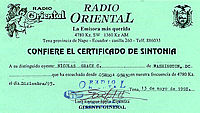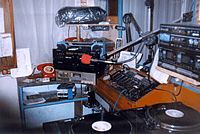Radio
Oriental, Napo, sent full data QSL card , personal letter
and sticker. I sent a reception report in English plus US$
1. Confirmation received in 121 days.
V/s Luis Enrique Espin Espinoza.
Marcelo Toniolo, USA, hcdx list, 11 May 2002
 Radio
Oriental, Tena, has returned from 4801 kHz to near the nominal
frequency of 4780. Radio
Oriental, Tena, has returned from 4801 kHz to near the nominal
frequency of 4780.
It was noted at 1102 on May 11, 2001, on 4782.6 kHz, with
newscast and ID announced by OM as "Transmite Radio Oriental
en 4780 kHz banda de 60 metros y 1100 en amplitud modulada
desde Tena, capital de Provincia de Napo, Ecuador. Son las
6 y 1 minuto en Ecuador Continental."
Takayuki Inoue Nozaki, Japan,
Relámpago DX, May 13, 2001

Radio Oriental, Tena, escuchada en 4801.2, variando entre
4801.17 - 4801.26 kHz, a 1058-1105 en 18/JUN/2000, con señal
regular a buena.
La emisora ha tenido dificultades técnicas consistentes
en el ajuste de su frecuencia de onda corta.
Durante la celebración del Día del Padre, fue
escuchada la siguiente identificación:
"Aquí le acompaña Oriental en los 4780 kHz banda
de 60 metros y 1100 kHz en amplitud modulada para celebrar
el día del padre."
Takayuki Inoue
Nozaki, Relampago DX, June 18, 2000

Radio Oriental, in Tena, Ecuador, has been logged
on 4800v kHz, March 29, at 0007-0015.
This is a move from 4782 kHz.
ID as "19 horas y 7 minutos... 7 horas y 7 minutos... continuamos
con 'El Expreso de la Noche'. Also slogan "Radio Oriental,
su Radio!"
On April 2 the station was heard on 4802 kHz at 0032. Still
anouncing "4780 KHz".
Yimber Gaviria, March
29, 2000, via Conexion

What do
you want to see?
By Nick Grace C.
 Elsa
and I sped through the spacious yards of Misión Josefina,
where La Voz del Napo resides, and wandered onto the lazy
streets of Tena with one place in mind: Radio Oriental.
"Let's see the Cuevas Jumandy," Elsa whined.
"Maybe the guy at Oriental can take us to see the antenna,
which has got to be near the caves and the Cuevas Jumandy!" Elsa
and I sped through the spacious yards of Misión Josefina,
where La Voz del Napo resides, and wandered onto the lazy
streets of Tena with one place in mind: Radio Oriental.
"Let's see the Cuevas Jumandy," Elsa whined.
"Maybe the guy at Oriental can take us to see the antenna,
which has got to be near the caves and the Cuevas Jumandy!"
We tripped upon the station's building and went right in.
Lilian Velín, Oriental's secretary, met us at the door and
insisted that we wait for the owner and station director,
Luis Enrique Espín Espinoza.
"But he came all the way from Washington," Elsa
told her.
"Sit down," she grumbled.
Yeah, sit down and take your number. The caves would
have to wait, too.
After an interminable wait Luis came in and gave me
an incredulous look.
"What do you want to see?" he asked me.
"Radio Oriental," I said as enthusiastically as
I could.
He frowned and then led us to his office a few doors down
from the entrance.
"There's not much to the station," he told us.
"Just this office and the on-air studio... I've
got to tell you that we've got a satellite dish on the roof
though!"
Elsa perked up and, thinking I'm obsessed with antennas, asked
him if we could see the dipole - just as long as it is near
the Jumandy Caves.
"No, I'm sorry it's not. It's about seven kilometers
outside of town."
We went to see the studio in all its glory: eight-channel
mixer, cassette decks, turntables, and a single microphone.
Like the other stations, the announcers sit in a separate
cabin from the producer.
Radio
Oriental, unlike La Voz del Napo, is a commercial venture.
It has been on MW for 20 years and began its SW service
for 4780 kHz on February 12, 1987. Luis said that about
five letters are received monthly and he responds to each
with a nice green QSL card. In a few weeks, he plans on
sending collectible photos of Indians and 200 sucre notes
to listeners.
The main problem for Radio Oriental - and the reason for
Luis' lack of enthusiasm for my visit - is that the station
isn't generating much revenue with its SW outlet.
However, although he has no plans to close it down he's
also not happy with interference "from Brazil"
that listeners apparently report about.
I suggested that he lobby the Ecuadorian government to change
Orientals frequency to a clear channel above 5.1 MHz, which
he quickly wrote down to do. Maybe my trip wasn't
such a waste after all!
Elsa and I thanked Luis and his secretary for their time
and generosity.
Copyright
©1998 by Nick Grace C., All Rights Reserved
Permission to reproduce and/or quote information from this
site for non-profit, educational purposes is freely granted,
always provided that proper reference of the site and sources
be included. Reproduction and/or citation for profit and/or
non-educational purposes is expressly forbidden without
prior consent from the author.
|